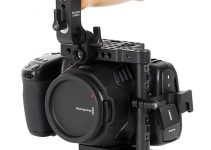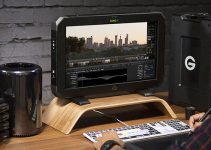More often than not, if you’re working as a wedding videographer, ENG, or a documentary kind of shooter, you’ll find that any kind of tool or tip that can speed up your work, or even get it slightly faster and less cumbersome, is more than welcome. So, thinking of those who work in this kind of environment, many are still reluctant to use mirrorless or DSLRs instead of handheld or bigger ENG cameras because of the detachable lenses.
Overall, changing a lens takes precious seconds that quickly add up over time, not to mention that if you’re in a hostile environment, you could easily get dust, moisture, and whatnot on your camera’s sensor which is the last thing you want, especially when shooting in a pinch.
That’s why tips like the ones suggested in the video below could sometimes be a real lifesaver on set. Whatever the case may be, the workflow covered by Carl Yates from ProAV TV will allow you to double the use cases for each lens you’ve got in your gear bag. Here’s how.
Unlike the Sony A7 III, the siblings in the lower A6000 series sport a roughly 1.6x times smaller sensor than the regular full-frame. So, if you put an APS-C camera lens on the bigger sensor, it will take advantage only of the central portion of the image, thus cropping it and effectively behaving like a lens with a longer focal distance.
For this reason, many camera makers have developed smaller and cheaper lenses marketed to these smaller APS-C cameras. These lenses project the image on a smaller area, but if you put such piece of glass on a camera with a full-frame sensor it won’t cover the whole area, hence you’ll end up with a black circle around your footage as the light falls off on the border of the frame.
That’s why Sony has implemented a function called APS-C Crop Mode in their full-frame mirrorless cameras, the A7III included. By switching to only the central portion of the sensor, this mode allows shooters to use their APS-C lenses on the full-frame body. Now, here’s the trick.
If you activate the APS-C Crop mode when a regular lens is mounted on, you will be effectively using only the central portion of the sensor, meaning that you’ll be zooming in of a 1.6 factor give and take. In other words, the 100mm lens you are mounting instantly becomes a 160mm lens and so on…
The quality loss in the image is almost invisible, and the footage is still in 4K. It is just a tad softer, but it’s a matter of pixel-peeping. What instead can be another advantage is that the rolling shutter is even less.
If you set the mode as a custom function on your C1 or C2 button, you’ll actually have a one-touch instant duplicator right in camera. Couple that with a nice zoom lens and you may have found your next dream setup.
Last but not least, if you activate the Clear Image Zoom on the A7III, you’ll be adding another layer of magnification, except this time it will be purely based on digital zooming, so it would be better to keep this trick only for extreme situations.
Of course, having proper access to a wide variety of focal lengths will always be your best bet, but if you are working on a budget or you simply don’t have more than a couple of prime lenses at your disposal, these tips could definitely help you get some decent coverage on the fly.
[source: ProAV TV]
Order Links:
Sony Alpha a7 III Mirrorless Digital Camera (Body Only) (B&H, Amazon)
Disclaimer: As an Amazon Associate partner and participant in B&H and Adorama Affiliate programmes, we earn a small comission from each purchase made through the affiliate links listed above at no additional cost to you.




